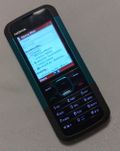
The battery of my 'voice call only' phone has pretty much given up after several years of use so it was time to buy a new low-end phone just for this purpose. Or almost. Inspired by this article of Krisse at All About Symbian, I decided to go for a Nokia 5000. While being an entry level phone and available for 90 euros without a contract, taxes and shipping included, it has a 320 x 240 pixels display that is really stunning. The resolution is the same as for example the display on the N95 but much smaller, hence, the the graphics are even sharper. With 65k colors the display can't quite match that of the N95 with 16 million, but it doesn't make a difference for the other main application besides making voice calls: web browsing.
Yes, you read correctly, web browsing. Nokia delivers the phone with Opera Mini pre-installed and I was looking forward to see how well web browsing works on such an entry level device. I quickly replaced the pre-installed Opera Mini with the latest version (4.1) as the original version had an ugly quick, it didn't save some of the settings I made in the browser. But the latest version works flawlessly.
Configuration and Startup Time
Launching Opera Mini takes a bit longer than on the N95 but 12 seconds is still quite acceptable. Once Opera Mini has started one can surf the web straight away. No APN or other configuration was required, as the Nokia 5000 seems to have an internal database of networks and their corresponding APNs. I tried with several different SIM cards and the correct APN was configured automatically in all cases. Well done Nokia, this is how it should be!
Page Load Times
Pages also don't load quite as quickly as on the N95 even though the device is EDGE capable. While downloading the latest version I could experience the speed gain of EDGE over GPRS. While loading a web page, however, the transmission is quite slow, probably because the browser is downloading and rendering the page at the same time, which seems to take a lot of processing power that is missing for treating incoming data quickly. Despite pages loading slower than on the N95, the experience is still o.k.
Scrolling
Scrolling up and down in the page is, yes, you guessed right, also slower than on the N95. However, using the full page up/down feature of the browser instead of scrolling line by line much improves the experience. Also switching off soft scrolling 'visual effects' in the configuration menu brings quite a significant speedup.
Memory Management
Memory seems to be quite scarce on the device. After loading a couple of big pages, a 'memory full' error message pops up every now and then with the screen remaining empty. Ignoring the message and reloading the page solves the issue, Opera Mini seems to use the notification to clear up memory. However, the number of pages one can scroll back is quite limited. Depending on the size of the pages, it's only possible to go back 2 to 4 pages without triggering a reload. On the N95 on the other hand, one can go back almost indefinitely without reloading earlier pages. Still, the experience is o.k.
No Multitasking
While being a bit slower than what I am used to which is quite o.k., there is one limitations which I have difficulties to cope with: No multitasking. While browsing the web on my N95 I am quite used to jump seamlessly between Opera Mini, the calendar to make notes when something comes to mind while browsing the web and the e-mail inbox to copy/paste links. The Nokia 5000, however, is a single tasking OS as far as user applications are concerned so I can't exit the browser without closing it.
The E-Mail Client
The second most important application on my mobile phone is e-mail. The S40 e-mail client looks quite o.k. and it gets all the required settings from a server on the network after typing in the email address. Impressive. The downside of automatic configuration is, however, that I can't get to the configuration information afterwards so I have no idea if my e-mails are encrypted during transmission. When configuring an e-mail account manually, this can be set during the configuration process and changed later on. While receiving email works quite well, the client can unfortunately only retrieve the full e-mail or only the header, but nothing in between. This makes the client completely unusable for me as I often receive e-mails with attachments. While I am usually not interested in the attachments on the phone, I'd like to read the message itself and not only the header. I can't quite understand why this feature didn't make it into the e-mail client!? But o.k. there's still the mobile web client for my inbox.
Summary
For phone that costs 'only' 90 euros, the Nokia 5000 is extraordinarily versatile. The biggest disadvantages I could make out are the somewhat slow but still acceptable scrolling in the browser, no multitasking and the missing support for partial e-mail downloads. On the positive side there is the Opera Mini browser that works really well, renders even full web pages just as on my N95 and also the auto-configuration of the packet data parameters. So if you don't have a lot of money and want to browse the web from a mobile with a good screen, this is the phone for you!